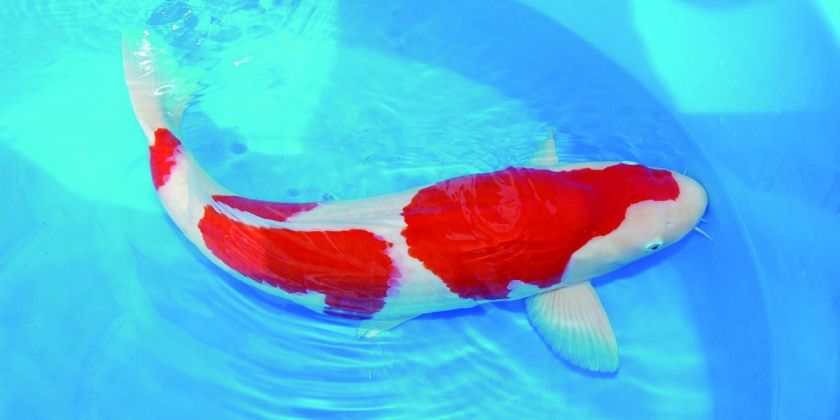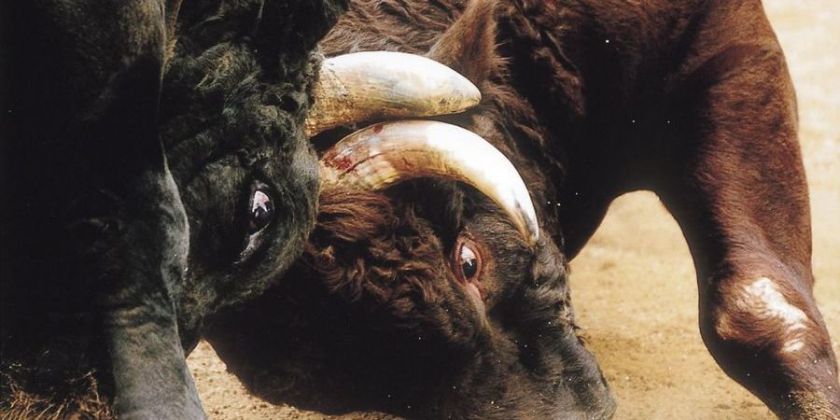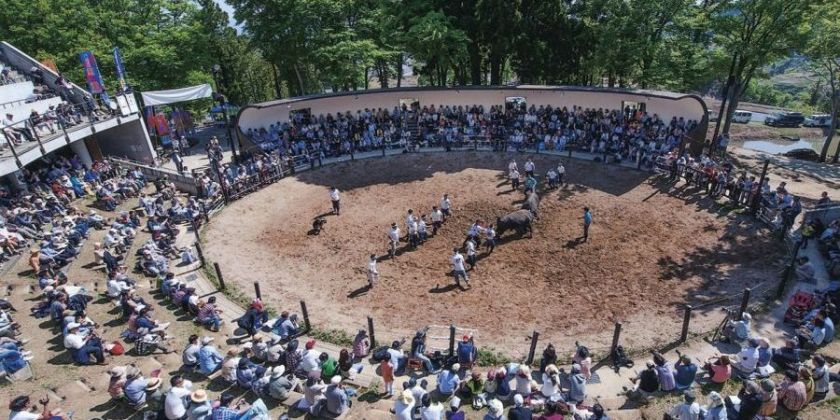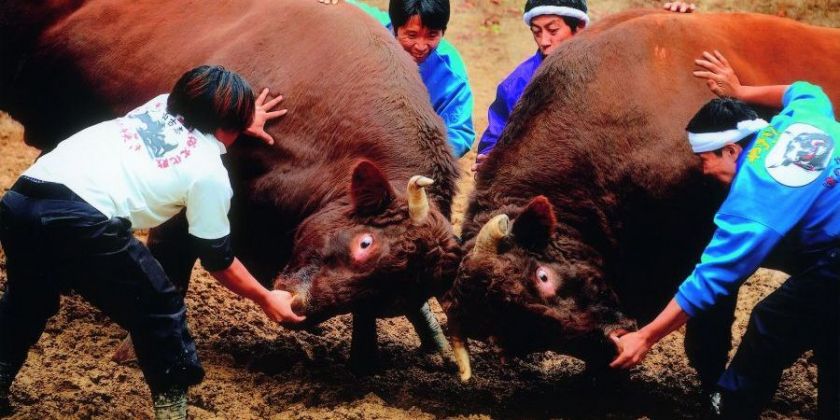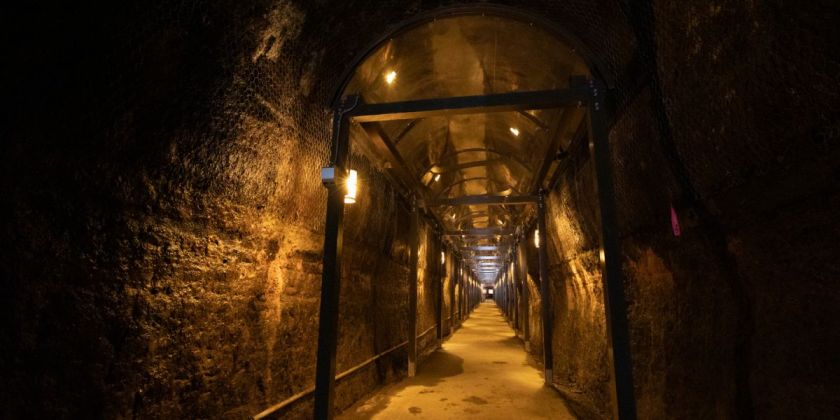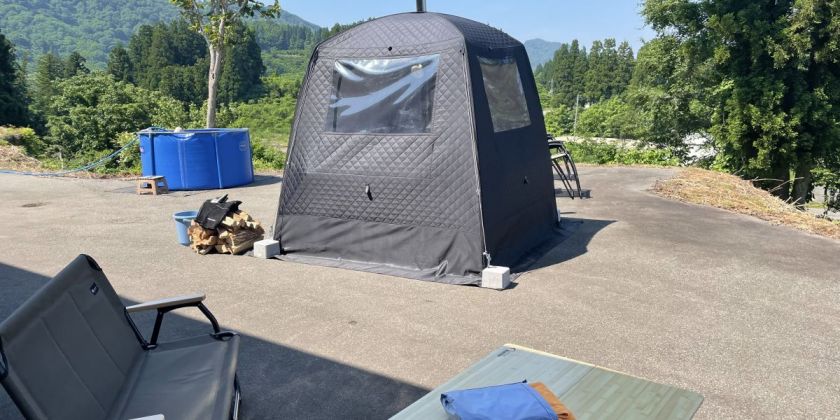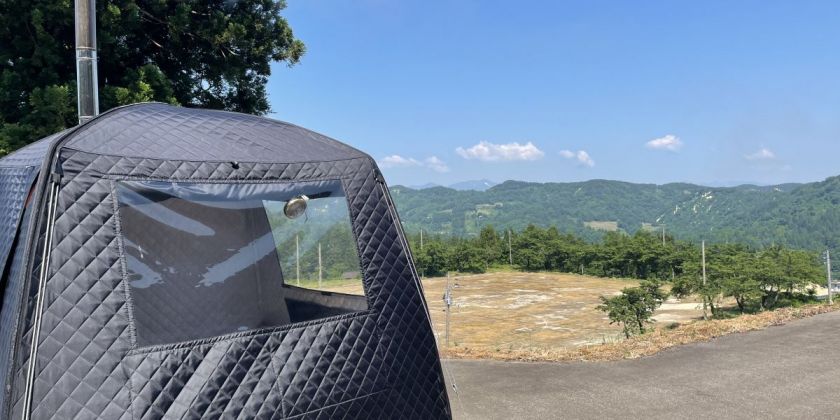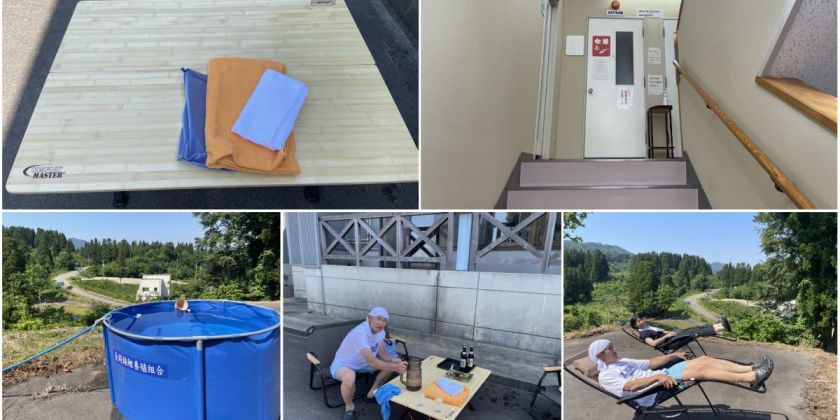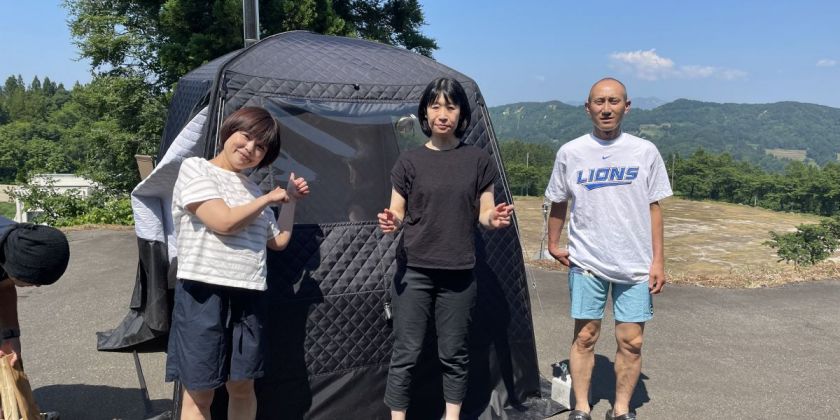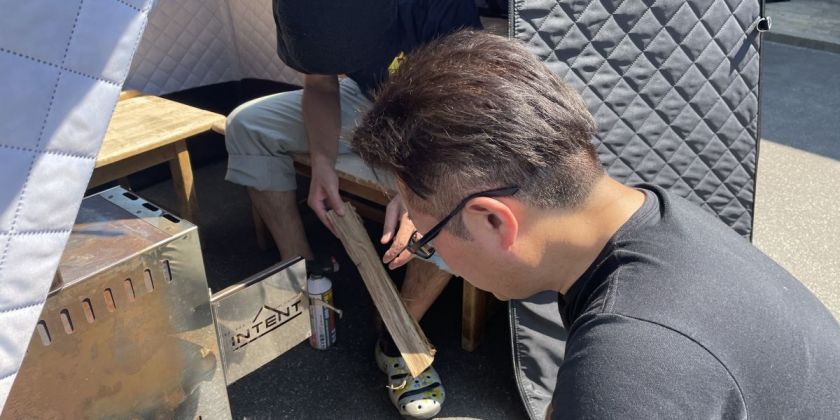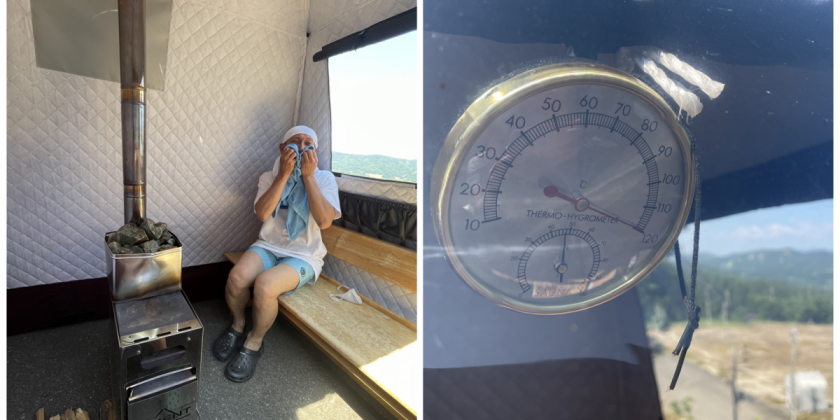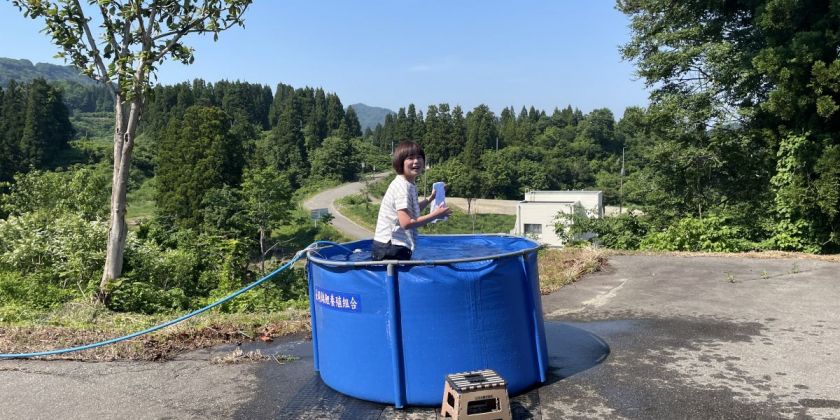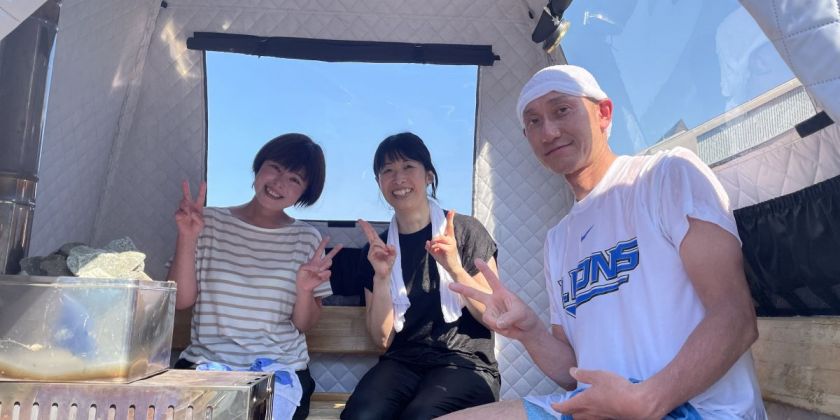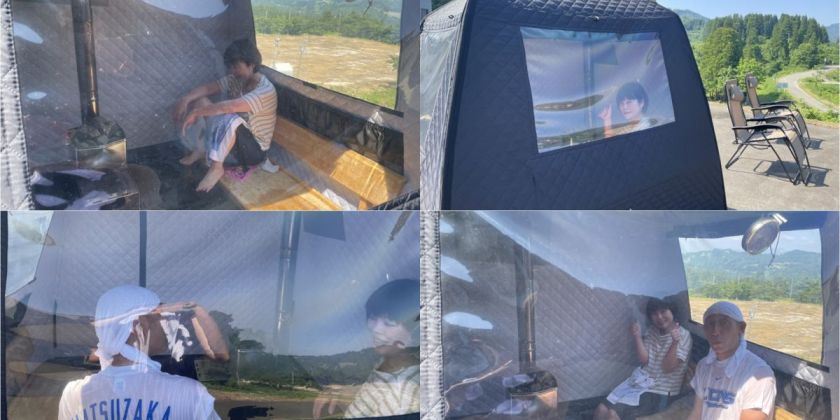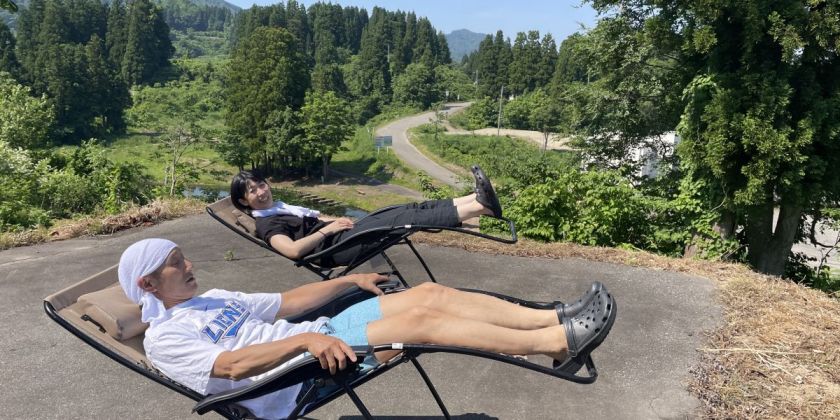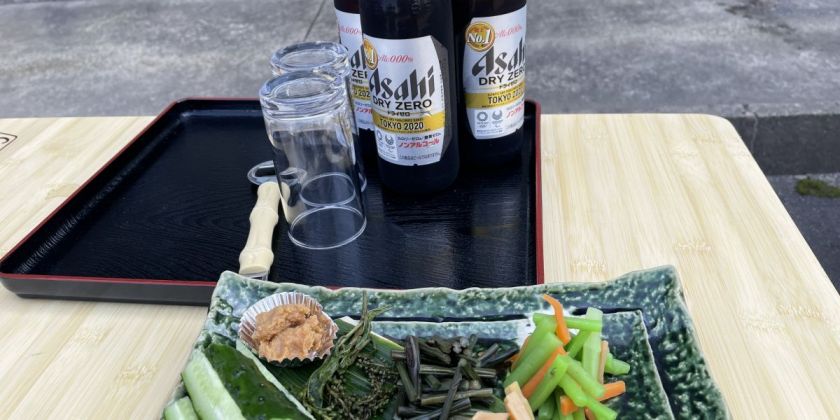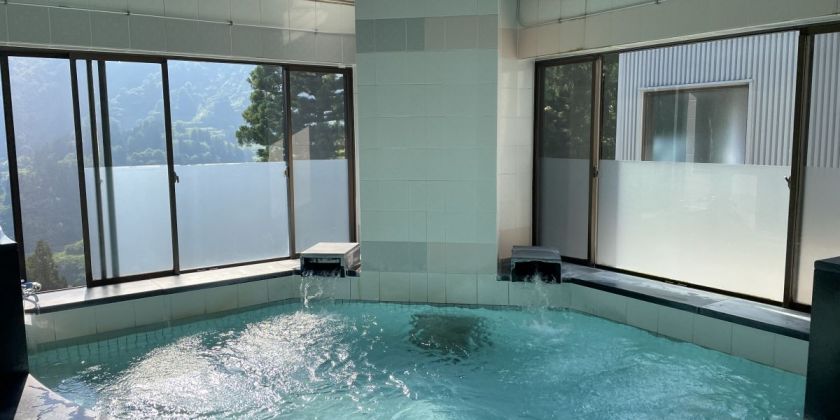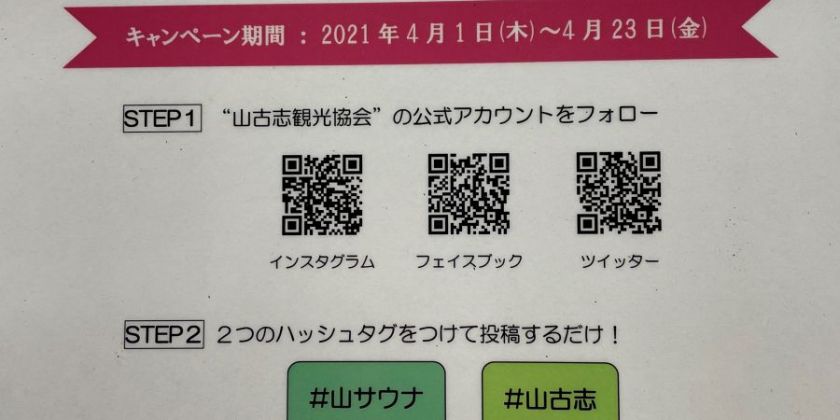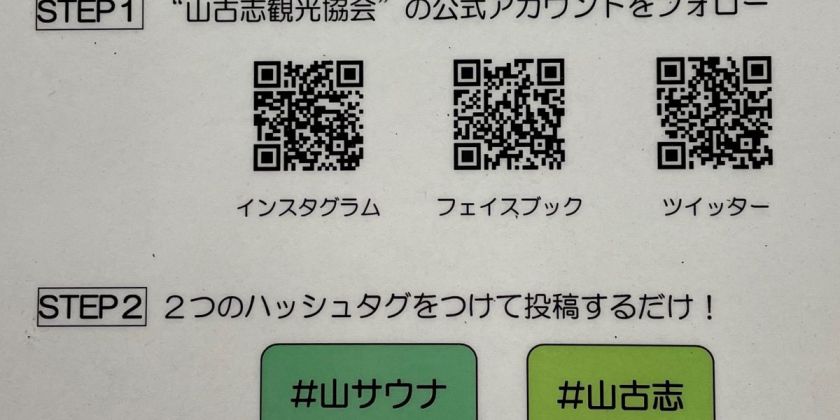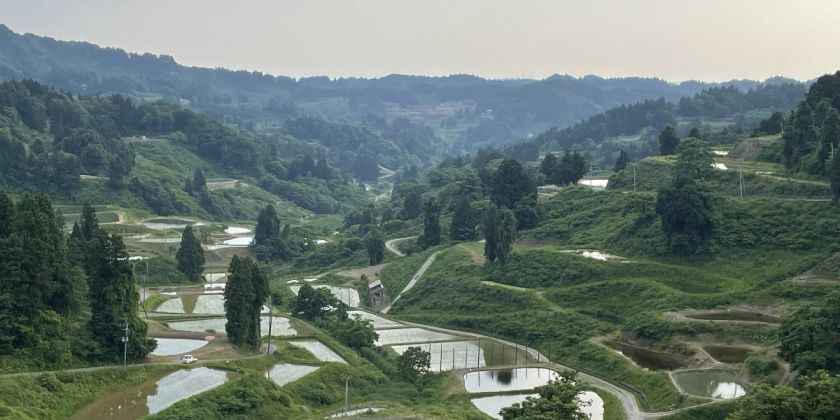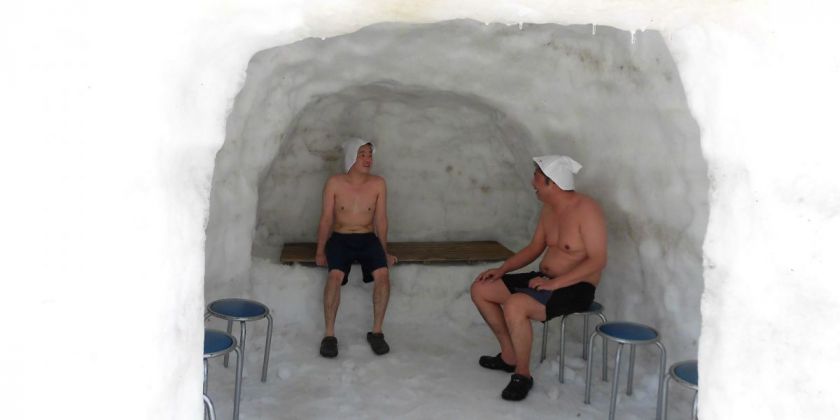
About Yamakoshi
In the Yamakoshi area, Nishikigoi farming, farming, and Tsunotsuki Bullfighting Tournaments have been held since ancient times and are still being carried on today. The scenery of the area is very fantastic, with terraced rice fields spreading out.
Ornamental Carp Breeding in Yamakoshi
The Yamakoshi area of Nagaoka is known for breeding and raising nishikigoi, multicolored ornamental carp considered beautiful enough to be called “living jewels.” Of more than 150 nishikigoi breeders in the Nagaoka region, approximately 90 commercial and hobby farms are based in Yamakoshi. Each year, many people visit to buy carp from breeders dedicated to the highest standards of care and quality. The koi were historically raised in water-filled terraced rice paddies on the steep slopes of the valley, and they are still kept in some of the terraced ponds in summer. Farmers and breeders put great effort into the maintenance and conservation of the traditional terraced scenery, which can be admired from locations such as Nikoniko Hiroba or Yakushi no Oka. The views are particularly impressive in early summer when colorful sunsets reflect off the water in the fields and ponds.
The History of Nishikigoi Breeding in Yamakoshi
The residents of Yamakoshi began breeding nishikigoi (literally “brocaded carp”) approximately two centuries ago. Before that, they had raised plain black magoi carp as food for the winter, as it was difficult to hunt or travel to procure provisions during periods of heavy snow. Magoi eggs were placed in flooded rice paddies in the spring, where the fish would spawn and mature among the rice plants. Once the carp reached a certain size, they were moved to dedicated terraced ponds. Before snowfall, the fish were transferred to easily accessible household ponds, where they became a ready source of protein. It is said that a fish with a red pattern was found among the black carp sometime in the early nineteenth century, and instead of eating it, the farmers decided to breed it to produce more colorful koi. Since then, scientific research and selective breeding have resulted in approximately 100 different color variations of decorative nishikigoi.
The nishikigoi of Yamakoshi became known throughout the country after the Tokyo Taisho Exhibition that took place in 1914. In 1916, hybrid crossbreeding replaced pure strain breeding and was used to produce an even greater variety of color patterns. Over time, Yamakoshi nishikigoi gained a following among buyers and koi hobbyists abroad, and Yamakoshi breeders were among the first in Japan to sell their carp internationally. In 2004, the Chuetsu earthquake in Niigata Prefecture caused extensive damage in Yamakoshi, ruining koi ponds and forcing residents to evacuate. Despite the setback, nishikigoi breeders managed to rebuild in just three years and revived their businesses with the assistance of other breeders and koi enthusiasts across the country. Today, Yamakoshi nishikigoi are prized additions to fish ponds throughout the world. During the selling season, the mountain village becomes a bustling marketplace as potential buyers arrive from across the globe to choose their own “living jewels.”
A Year at a Nishikigoi Farm
The breeding season begins in April and May, when selected nishikigoi are paired off with the hope that they produce offspring with the desired color patterns. Although the exact approach may vary by breeder, the typical method involves having the fish deposit eggs on artificial aquatic grasses in breeding pools. The eggs are then moved to a different pool to hatch safely with the other fry. In the following months, the fish undergo periodic culling based on pattern, state of health, and other criteria. Of the approximately 200,000 carp spawned, only 500 to 1,000 make it to adulthood.
Throughout the summer, farmworkers make sure that each koi gets the proper amount of food, is free of worms or parasites, and is protected from scavenging animals. Each farm maintains multiple ponds to separate young fry and adult fish by size or color pattern, and farmers must regularly inspect the ponds to ensure that the koi remain healthy as they grow.
In October and November, the nishikigoi are transferred to more protected greenhouse pools for the winter, and until April they are raised indoors. During this time, potential buyers visit to select carp and breeders enter their best specimens in trade shows and contests. Specially designed boxes are used to ship the purchased nishikigoi inside bags of cold, oxygenated water that keeps the fish calm. When spring comes, the remaining carp are released back into outdoor ponds to continue growing, and the spawning cycle begins again for a new generation of nishikigoi.
*This English-language text was created by the Japan Tourism Agency.
The History of Nishikigoi Breeding in Yamakoshi
The residents of Yamakoshi began breeding nishikigoi (literally “brocaded carp”) approximately two centuries ago. Before that, they had raised plain black magoi carp as food for the winter, as it was difficult to hunt or travel to procure provisions during periods of heavy snow. Magoi eggs were placed in flooded rice paddies in the spring, where the fish would spawn and mature among the rice plants. Once the carp reached a certain size, they were moved to dedicated terraced ponds. Before snowfall, the fish were transferred to easily accessible household ponds, where they became a ready source of protein. It is said that a fish with a red pattern was found among the black carp sometime in the early nineteenth century, and instead of eating it, the farmers decided to breed it to produce more colorful koi. Since then, scientific research and selective breeding have resulted in approximately 100 different color variations of decorative nishikigoi.
The nishikigoi of Yamakoshi became known throughout the country after the Tokyo Taisho Exhibition that took place in 1914. In 1916, hybrid crossbreeding replaced pure strain breeding and was used to produce an even greater variety of color patterns. Over time, Yamakoshi nishikigoi gained a following among buyers and koi hobbyists abroad, and Yamakoshi breeders were among the first in Japan to sell their carp internationally. In 2004, the Chuetsu earthquake in Niigata Prefecture caused extensive damage in Yamakoshi, ruining koi ponds and forcing residents to evacuate. Despite the setback, nishikigoi breeders managed to rebuild in just three years and revived their businesses with the assistance of other breeders and koi enthusiasts across the country. Today, Yamakoshi nishikigoi are prized additions to fish ponds throughout the world. During the selling season, the mountain village becomes a bustling marketplace as potential buyers arrive from across the globe to choose their own “living jewels.”
A Year at a Nishikigoi Farm
The breeding season begins in April and May, when selected nishikigoi are paired off with the hope that they produce offspring with the desired color patterns. Although the exact approach may vary by breeder, the typical method involves having the fish deposit eggs on artificial aquatic grasses in breeding pools. The eggs are then moved to a different pool to hatch safely with the other fry. In the following months, the fish undergo periodic culling based on pattern, state of health, and other criteria. Of the approximately 200,000 carp spawned, only 500 to 1,000 make it to adulthood.
Throughout the summer, farmworkers make sure that each koi gets the proper amount of food, is free of worms or parasites, and is protected from scavenging animals. Each farm maintains multiple ponds to separate young fry and adult fish by size or color pattern, and farmers must regularly inspect the ponds to ensure that the koi remain healthy as they grow.
In October and November, the nishikigoi are transferred to more protected greenhouse pools for the winter, and until April they are raised indoors. During this time, potential buyers visit to select carp and breeders enter their best specimens in trade shows and contests. Specially designed boxes are used to ship the purchased nishikigoi inside bags of cold, oxygenated water that keeps the fish calm. When spring comes, the remaining carp are released back into outdoor ponds to continue growing, and the spawning cycle begins again for a new generation of nishikigoi.
*This English-language text was created by the Japan Tourism Agency.
Tsunotsuki Bullfighting Tournaments in Yamakoshi
Yamakoshi is one of nine places in Japan still holding traditional contests of strength between bulls. The practice is thought to have started in this rural, mountainous area in southeastern Nagaoka about a thousand years ago, when villagers relied on cattle for farm work and transportation. Bouts between bulls served as entertainment when the animals were not involved in planting or harvesting crops. The pastime became more organized in the Edo period (1603–1867) and was particularly popular in the late nineteenth and early twentieth centuries. Activities were briefly suspended in 2004, after an earthquake caused extensive damage in the area, but the tradition was revived through efforts of the Yamakoshi residents and support received from other bullfighting communities across the country.
Competitions between bulls in the ring are called tsunotsuki (literally “horn thrusting”) in Yamakoshi, while people in other regions use the words for “bullfighting” or “bull sumo.” It is a nationally designated Important Intangible Folk Cultural Property.
No Winners or Losers
Tsunotsuki in Yamakoshi is differentiated from other types of bullfighting by the effort to prevent injury to the bulls. In Yamakoshi, they were primarily farm animals that performed important tasks, such as field work and transporting goods on steep mountain roads unsuitable for horses. The bulls were raised and kept in the owner’s home and were often considered members of the family. If a bull were seriously injured in a fight, it would be unable to work, dramatically impacting the livelihood of its owner. In addition, allowing clear winners and losers in the bouts could lead to negative feelings among villagers in the small community.
For these reasons, it became tradition in Yamakoshi to declare a draw before either of the bulls got hurt. The bull handlers in the ring, called seko, closely watch each bout to decide when it is best to separate the animals. The draw is announced at the climax of the match, after both bulls have displayed their strength and entertained the spectators, or when it seems that one bull might overpower or hurt the other.
Tsunotsuki Tournaments
Several aspects of the tsunotsuki bullfighting tradition in Yamakoshi resemble sumo wrestling. Tournaments are held from May through November, taking place on weekends once or twice a month at the Yamakoshi Bullring. They are comprised of ten to thirteen bouts, beginning with training matches for young bulls and followed by competitions between stronger and more experienced animals that are expected to clash more dramatically.
At the beginning, the bullring is ritually purified with salt and sake, and the seko handlers gather in a circle with organizers to clap and raise their arms in hope for a safe tournament. During the bouts, an announcer in the ring narrates the action, providing information about the animals and passionate commentary. The early matches are held between bulls with ropes tied to their nose rings in case the seko need to guide or separate them quickly. The bulls in later matches are sometimes released to compete more freely. When the draw is declared, ropes are swiftly attached to the bulls’ back legs to pull them apart, and the seko force themselves between the animals to separate their horns if needed.
The Competing Bulls
The bulls who take part in the Yamakoshi tsunotsuki tournaments debut in the spring when they are three years old. There is no set retirement age, and bulls as old as nineteen have competed in the ring. Although the bulls that historically participated in tsunotsuki were primarily farm animals, now they are kept exclusively for the matches. Each bull is given a masculine, dramatic-sounding name in keeping with traditions found in sumo wrestling. The names may also contain references to the bull owners’ businesses. Currently, there are approximately 50 bulls taking part in tournaments.
The Yamakoshi Bullring
The bullring is located on the top of a hill surrounded by rice fields. A bus is available to take spectators from Nagaoka Station to the bullring on tournament days, but most people travel by car. A low wall on one side of the path to the ring displays information about the history of Yamakoshi tsunotsuki, including Edo-period illustrations and black-and-white photographs portraying life with the bulls and scenes of airlifting them to safety after the 2004 earthquake. The ring can accommodate around 1,500 people, and thin cushions for the seats are provided at the venue. Several stalls set up on tournament days sell food, drinks, and handmade goods. Admission costs 2,500 yen for adults and is free for children under 16.
*This English-language text was created by the Japan Tourism Agency.
Competitions between bulls in the ring are called tsunotsuki (literally “horn thrusting”) in Yamakoshi, while people in other regions use the words for “bullfighting” or “bull sumo.” It is a nationally designated Important Intangible Folk Cultural Property.
No Winners or Losers
Tsunotsuki in Yamakoshi is differentiated from other types of bullfighting by the effort to prevent injury to the bulls. In Yamakoshi, they were primarily farm animals that performed important tasks, such as field work and transporting goods on steep mountain roads unsuitable for horses. The bulls were raised and kept in the owner’s home and were often considered members of the family. If a bull were seriously injured in a fight, it would be unable to work, dramatically impacting the livelihood of its owner. In addition, allowing clear winners and losers in the bouts could lead to negative feelings among villagers in the small community.
For these reasons, it became tradition in Yamakoshi to declare a draw before either of the bulls got hurt. The bull handlers in the ring, called seko, closely watch each bout to decide when it is best to separate the animals. The draw is announced at the climax of the match, after both bulls have displayed their strength and entertained the spectators, or when it seems that one bull might overpower or hurt the other.
Tsunotsuki Tournaments
Several aspects of the tsunotsuki bullfighting tradition in Yamakoshi resemble sumo wrestling. Tournaments are held from May through November, taking place on weekends once or twice a month at the Yamakoshi Bullring. They are comprised of ten to thirteen bouts, beginning with training matches for young bulls and followed by competitions between stronger and more experienced animals that are expected to clash more dramatically.
At the beginning, the bullring is ritually purified with salt and sake, and the seko handlers gather in a circle with organizers to clap and raise their arms in hope for a safe tournament. During the bouts, an announcer in the ring narrates the action, providing information about the animals and passionate commentary. The early matches are held between bulls with ropes tied to their nose rings in case the seko need to guide or separate them quickly. The bulls in later matches are sometimes released to compete more freely. When the draw is declared, ropes are swiftly attached to the bulls’ back legs to pull them apart, and the seko force themselves between the animals to separate their horns if needed.
The Competing Bulls
The bulls who take part in the Yamakoshi tsunotsuki tournaments debut in the spring when they are three years old. There is no set retirement age, and bulls as old as nineteen have competed in the ring. Although the bulls that historically participated in tsunotsuki were primarily farm animals, now they are kept exclusively for the matches. Each bull is given a masculine, dramatic-sounding name in keeping with traditions found in sumo wrestling. The names may also contain references to the bull owners’ businesses. Currently, there are approximately 50 bulls taking part in tournaments.
The Yamakoshi Bullring
The bullring is located on the top of a hill surrounded by rice fields. A bus is available to take spectators from Nagaoka Station to the bullring on tournament days, but most people travel by car. A low wall on one side of the path to the ring displays information about the history of Yamakoshi tsunotsuki, including Edo-period illustrations and black-and-white photographs portraying life with the bulls and scenes of airlifting them to safety after the 2004 earthquake. The ring can accommodate around 1,500 people, and thin cushions for the seats are provided at the venue. Several stalls set up on tournament days sell food, drinks, and handmade goods. Admission costs 2,500 yen for adults and is free for children under 16.
*This English-language text was created by the Japan Tourism Agency.
Old Nakayama Tunnel
The old Nakayama Tunnel in the Komatsugura area of southeastern Nagaoka is the longest hand-dug tunnel in Japan, stretching for 877 meters. It was built by the residents of Komatsugura between 1933 and 1949 as an alternative to a long and dangerous mountain pass. For almost 50 years, the tunnel provided a safer route to the neighboring villages and was enlarged twice to allow passage for horse carts and then automobiles. It was closed to traffic in 1998, when the new Nakayama Tunnel was completed nearby. The western side of the old tunnel still allows visitors to walk along part of the route and view the original structure. For safety reasons, entry is not permitted beyond the first 70 meters.
The Need for a Safer Route
Komatsugura did not have a general store or a hospital, so the residents had to rely on the nearby villages, Hirokami and Koide (both in present-day Uonuma), for medical treatment and certain daily necessities. The only way to reach the two villages was by a poorly maintained four-kilometer mountain path, and heavy winter snowfall made the journey especially dangerous. As a result, some residents could not receive urgent medical care and others got into accidents while attempting to travel the path. This eventually spurred the Komatsugura community to devise a way to bypass the mountain route. The plan for building the tunnel was finalized in 1932, and construction began on November 12th, 1933.
Construction of the Tunnel
Funds for construction were largely raised through donations from the community and through the sale of land and other assets. The villagers worked in shifts to dig the tunnel with pickaxes and shovels. Wooden minecarts were used to remove the excavated earth and stone, and bellows pumped fresh air into the deeper parts of the tunnel. In addition to the slow speed of manual digging, flooding and fundraising issues lead to delays, and the Second Sino-Japanese War (1937–1945) caused a four-year interruption in construction. In 1949, workers digging from the east and from the west finally joined the two sections of the tunnel, completing the 16-year project.
Legacy
The old Nakayama Tunnel was slated for demolition after closure, but community members launched an initiative to preserve the structure in recognition of its historical significance. Donations were used to produce a documentary detailing the tunnel’s importance to the residents of Komatsugura and the struggles they faced during construction. The film Horumaika (Should We Dig?) was released in 2003 and won several awards, contributing to the successful preservation of the tunnel.
The Japan Society of Civil Engineers lists the old Nakayama Tunnel as a valuable example of the country’s civil engineering heritage.
*This English-language text was created by the Japan Tourism Agency.
The Need for a Safer Route
Komatsugura did not have a general store or a hospital, so the residents had to rely on the nearby villages, Hirokami and Koide (both in present-day Uonuma), for medical treatment and certain daily necessities. The only way to reach the two villages was by a poorly maintained four-kilometer mountain path, and heavy winter snowfall made the journey especially dangerous. As a result, some residents could not receive urgent medical care and others got into accidents while attempting to travel the path. This eventually spurred the Komatsugura community to devise a way to bypass the mountain route. The plan for building the tunnel was finalized in 1932, and construction began on November 12th, 1933.
Construction of the Tunnel
Funds for construction were largely raised through donations from the community and through the sale of land and other assets. The villagers worked in shifts to dig the tunnel with pickaxes and shovels. Wooden minecarts were used to remove the excavated earth and stone, and bellows pumped fresh air into the deeper parts of the tunnel. In addition to the slow speed of manual digging, flooding and fundraising issues lead to delays, and the Second Sino-Japanese War (1937–1945) caused a four-year interruption in construction. In 1949, workers digging from the east and from the west finally joined the two sections of the tunnel, completing the 16-year project.
Legacy
The old Nakayama Tunnel was slated for demolition after closure, but community members launched an initiative to preserve the structure in recognition of its historical significance. Donations were used to produce a documentary detailing the tunnel’s importance to the residents of Komatsugura and the struggles they faced during construction. The film Horumaika (Should We Dig?) was released in 2003 and won several awards, contributing to the successful preservation of the tunnel.
The Japan Society of Civil Engineers lists the old Nakayama Tunnel as a valuable example of the country’s civil engineering heritage.
*This English-language text was created by the Japan Tourism Agency.
What is the Private Sauna ?
You can now experience sauna in the Yamakoshi area of Nagaoka City.
The private tent saunas in Yamakoshi are the hottest tent saunas in the world. They were developed in Russia and air temperatures inside can reach nearly 120 degrees Celsius (248 degrees Fahrenheit). This is quite a bit hotter than most Finnish saunas, which range from 80 to 100 degrees Celsius (176 to 212 degrees Fahrenheit), and is sure to satisfy those who truly love saunas.
The private tent saunas in Yamakoshi are the hottest tent saunas in the world. They were developed in Russia and air temperatures inside can reach nearly 120 degrees Celsius (248 degrees Fahrenheit). This is quite a bit hotter than most Finnish saunas, which range from 80 to 100 degrees Celsius (176 to 212 degrees Fahrenheit), and is sure to satisfy those who truly love saunas.
Preparing to Use the Sauna
You can enjoy this private tent sauna in the area behind Amayachi-no-Yu, the inn with the highest elevation in Yamakoshi. When you register for the sauna at Amayachi Kaikan, the main building, you can borrow a set of towels. There is a changing room in the bath area, so women have no need to worry. It would be best if you have a sauna outfit, but a T-shirt and shorts will suffice. (Keep in mind that you will go directly to the cold water bath as is, so we recommend a T-shirt that dries quickly and has a non-transparent color.) Firewood, a cold water bath, and a table and bench set are provided in addition to the towel set. Once you change your clothes, it’s time for the tent sauna.
Time for a Private Sauna Experience
These three people who look like they are likely to have toxins building up in their bodies on a daily basis will try the private tent sauna.
First, the sauna attendant lights the firewood. After that, the users add firewood or sprinkle water on the hot rocks to create steam according to their needs.
The temperature in the tent reaches 120 degrees Celsius in no time. One of the members, who is not a big fan of saunas, can’t stand the intense heat, even though she knows that it will help rid her body of accumulated toxins. She feels like the inside of her nose is burning.
Not just her nose, but even her lungs can’t handle the prickly heat. She jumps straight into the cold water bath. The bracing rush from the cold water brings such a feeling of release!
At about 90 to 100 degrees Celsius, the sauna should be comfortable for those new to saunas, and they can even enjoy talking with their friends.
Don’t think about anything other than the waste products of aging flowing from your body and simply enjoy the sauna.
After several round trips from the sauna to the cold water bath, it’s time for a break. It’s very important to stay hydrated. The winds blowing through the mountains of Yamakoshi bring comfort and cool your skin, which has been warmed from the core of your body. You can refresh yourself by simply entrusting your body to the rich nature of Yamakoshi.
You can also order drinks and snacks at Amayachi Kaikan. Pictured here is a non-alcoholic beer, but the strange thing is, relaxing and drinking this in the midst of the nature of Yamakoshi, you begin to feel drunk. Also, the pickles here have just the right amount of salt, perfect for replenishing what was lost with sweating in the sauna.
After the sauna, you can enjoy another bath at Amayachi-no-Yu. The scenery from the large windows provides a wonderful sense of liberation.
Detailed Information
Amayachi-no-Yu (main building: Amayachi Kaikan)
●Location: 4526 Yamakoshi-Tanesuhara, Nagaoka
●Business hours:
Bath: 9:30 a.m. - 4:30 p.m.
Cafeteria: 11:00 a.m. - 2:00 p.m.
●Bath fees:
High school students and above: 500 yen
(16 years old and up)
Elementary and junior high school students: 300 yen
(6-15 years old)
Persons with disabilities and caregivers: 300 yen
●Room charge: from 7,400 yen/night
●Closed on Tuesdays
●Inquiries: Yamakoshi Tourism Association Secretariat
E-mail: ymks-sangyo@city.nagaoka.lg.jp
●Location: 4526 Yamakoshi-Tanesuhara, Nagaoka
●Business hours:
Bath: 9:30 a.m. - 4:30 p.m.
Cafeteria: 11:00 a.m. - 2:00 p.m.
●Bath fees:
High school students and above: 500 yen
(16 years old and up)
Elementary and junior high school students: 300 yen
(6-15 years old)
Persons with disabilities and caregivers: 300 yen
●Room charge: from 7,400 yen/night
●Closed on Tuesdays
●Inquiries: Yamakoshi Tourism Association Secretariat
E-mail: ymks-sangyo@city.nagaoka.lg.jp
We have a special campaign in which you can get a 10% discount off the basic set price if you post about the Yamakoshi Private Sauna on social media. Currently, no end date for the campaign has been set, so you can continue to enjoy this discount for the time being.
1. Follow the official account of the Yamakoshi Tourism Association on Instagram, Facebook, or Twitter.
2. Tell the receptionist that you will participate in the campaign.
3. Pay the fee (at 10% off!).
4. Enjoy the private sauna.
5. Post on your social media with these two hashtags: #Yamasauna and #Yamakoshi.
6. After you finish enjoying the sauna, show the staff your social media post.
1. Follow the official account of the Yamakoshi Tourism Association on Instagram, Facebook, or Twitter.
2. Tell the receptionist that you will participate in the campaign.
3. Pay the fee (at 10% off!).
4. Enjoy the private sauna.
5. Post on your social media with these two hashtags: #Yamasauna and #Yamakoshi.
6. After you finish enjoying the sauna, show the staff your social media post.
It is said that going back and forth several times from a sauna to a cold water bath has various health effects such as improving circulation, increasing metabolism, removing the waste products of aging, and rejuvenating internal organs. That being said, the most beneficial thing about the Yamakoshi Private Sauna may be its ability to increase relaxation. We would like to invite people whose daily lives are busy and full of stress to come and experience a relaxing time in the nature of Yamakoshi. We are confident that you will feel refreshed and that it will bring a smile to your face.
The Yamakoshi Private Sauna can be enjoyed all year round. In winter, when it snows, you may be lucky enough to experience a kamakura (snow hut) instead of the cold water bath. Even we want to experience cooling off in a kamakura! How about enjoying yourself in your own private sauna in the rich nature of Yamakoshi?
The Yamakoshi Private Sauna can be enjoyed all year round. In winter, when it snows, you may be lucky enough to experience a kamakura (snow hut) instead of the cold water bath. Even we want to experience cooling off in a kamakura! How about enjoying yourself in your own private sauna in the rich nature of Yamakoshi?
~Yamakoshi Private Sauna~
●Standard party size: 4 people
●Usage fee: 10,000 yen (plus 1,000 yen per additional person after the fourth)
●Includes: Firewood, cold water bath, table and bench set, towel, one free soft drink, Amayachi-no-Yu bathing fee
●Time slots: Morning session from 9:00 a.m. to 12:00 p.m. (3 hours)
Afternoon session from 1:00 p.m. to 4:00 p.m. (3 hours)
●Reservations required!
Reservations must be made at least three days prior to the desired date of use, and will be accepted from one month before the desired date of use.
●Inquiries: Yamakoshi Tourism Association Secretariat
E-mail: ymks-sangyo@city.nagaoka.lg.jp
●Standard party size: 4 people
●Usage fee: 10,000 yen (plus 1,000 yen per additional person after the fourth)
●Includes: Firewood, cold water bath, table and bench set, towel, one free soft drink, Amayachi-no-Yu bathing fee
●Time slots: Morning session from 9:00 a.m. to 12:00 p.m. (3 hours)
Afternoon session from 1:00 p.m. to 4:00 p.m. (3 hours)
●Reservations required!
Reservations must be made at least three days prior to the desired date of use, and will be accepted from one month before the desired date of use.
●Inquiries: Yamakoshi Tourism Association Secretariat
E-mail: ymks-sangyo@city.nagaoka.lg.jp

